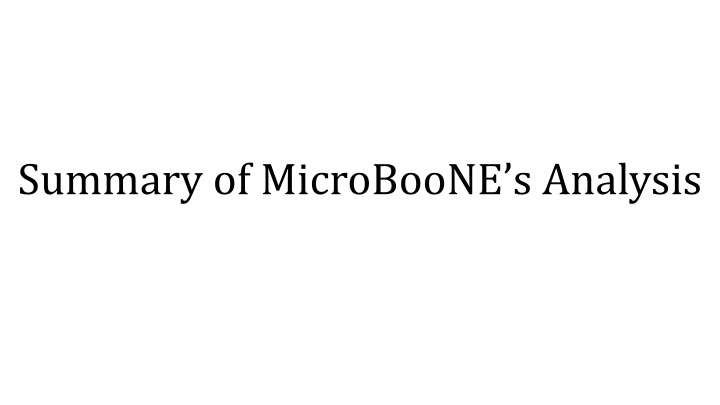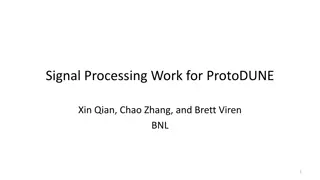
MicroBooNE Neutrino Analysis Insights
"Explore the analysis of MicroBooNE and the search for sterile neutrinos, involving systematic uncertainties, data sets, and energy reconstruction techniques."
Uploaded on | 3 Views
Download Presentation

Please find below an Image/Link to download the presentation.
The content on the website is provided AS IS for your information and personal use only. It may not be sold, licensed, or shared on other websites without obtaining consent from the author. If you encounter any issues during the download, it is possible that the publisher has removed the file from their server.
You are allowed to download the files provided on this website for personal or commercial use, subject to the condition that they are used lawfully. All files are the property of their respective owners.
The content on the website is provided AS IS for your information and personal use only. It may not be sold, licensed, or shared on other websites without obtaining consent from the author.
E N D
Presentation Transcript
Background of sterile neutrino Neutrino s mass needs to explain(In standard model, neutrino is expected 0 mass), which lead to sterile neutrino hypothsisy. MiniBooNE observed an anomalous excess of charge-current ??, which indicate exist of sterile neutrino.
Process of analysis Based early study of MicroBooNE, I analyzed full data set of MicroBooNE collected as following steps: Check the consistence of different period data set. Calculate relative uncertainty of cross section, BNB flux(neutrino comes from BNB), detector, MC sample and dirt. With all systematic uncertainty, calculate some kinds of ?2tests. Then we can get the result.
Method of analysis In analysis, following 7-channel are used : FC ??CC PC ??CC FC ??CC PC ??CC FC ?0CC PC ?0CC NC?0 After concerning some effect, MicroBooNE defined fiducial volume(3 cm inside the effective TPC boundary).
Data set used in analysis MicroBooNE divided data set to five sample, this analysis used following data set: Run1 Run2 Run3 Run4 Run5 Run1-3 are used in early analysis
Previous: FC CC?? Run1 Run2 Run3 X axis is reconstructed neutrino energy. By checking the shape of distribution, we can find some consistence in these plots. Run4 Run5 Systematic Uncertainties from MC XsFlux Dirt(no Det sys) 6
Recalculation of systematic uncertainty Recalculated result original result reconstructed neutrino energy reconstructed neutrino energy I have recalculated original result correctly.
Calculation of systematic uncertainty Run4 Run3 Big difference reconstructed neutrino energy reconstructed neutrino energy As marked in left plot, detector relative uncertainty has big difference.
Comparison of detector uncertainty PC ??CC FC ??CC FC ??CC PC ??CC ?03channel reconstructed neutrino energy All seven channels of Run5 are smaller than those of Run3 The five channels of Run4 (e.g. excluding ??CC) are smaller than the result of Run3
Method of calculating detector uncertainty Blue curve is 1sigma value Black curve is central value Detector uncertainty calculated based on each run s 9 detector samples. Generally, detector relative uncertainty is calculated based on detector sample s bias of central value of 1sigma value with statistical fluxion.
Checking on detector samples distribution Run4: ?? Run5: ?? Run3: ?? Different detector uncertainty may cause by detector sample themself. Run4/5 s 1sigma curves are similar with cv curve.
Further things of analysis We have confirmed what s going wrong in detector samples(sample s size of each run is different), so next plans are following: Waiting for new detector sample. Calculate some kinds of ?2 tests: goodness of fit, simple-vs-simple likelihood ratio test and nest likelihood ratio test. Then we will publish the final result.


